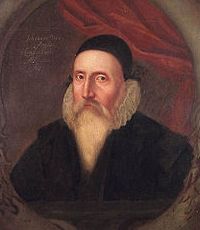


John Dee
London 1527 - Mortlake 1608
Matematico, geografo e alchimista, presso la corte della regina Elisabetta I. Si dedicò inoltre per la maggior parte della vita all'occultismo, alla divinazione e alla filosofia ermetica. All'età di 15 anni si trasferì a Cambridge per frequentare il St. John's College. Terminati gli studi con il baccalaureato nel 1546, fu nominato membro del Trinity College. Elisabetta I lo nominò cancelliere della Cattedrale di San Paolo a Londra, poi sovrintendente del Christ College di Manchester.
Opere principali: Monas hieroglyphica (1564); Propaedeumata aphoristica (1568); Parallacticae commentationis praxosque (1573); Perfect Arte of Navigation (1577).
Bibliografia: St. Clucas (ed.), John Dee: Interdisciplinary Studies in Renaissance Thought, Dordrecht, Springer 2006; N.H. Clulee, John Dee's Natural Philosophy: Between Science and Religion, London, Routledge 1988; Ch. Fell Smith, John Dee: 1527-1608, London, Constable and Company 1909; P.J. French, John Dee: The World of an Elizabethan Magus, London, Routledge & Kegan Paul 1972; M. Kugler, Astronomy in Elizabethan England, 1558 to 1585: John Dee, Thomas Digges, and Giordano Bruno, Montpellier, Université Paul Valéry 1982; W.H. Sherman, John Dee: The Politics of Reading and Writing in the English Renaissance, Amherst, University of Massachusetts Press 1995; B. Woolley, The Queen's Conjuror: The Science and Magic of Dr. John Dee, Adviser to Queen Elizabeth I, New York, Henry Holt and Company 2001; Fr. Yates, The Occult Philosophy in the Elizabethan Age, London; Routledge 2001; Fr. Yates, Renaissance Philosophers in Elizabethan England: John Dee and Giordano Bruno, in Ead., Lull & Bruno, collected essays vol. I, London, Routledge & Kegan 1982.